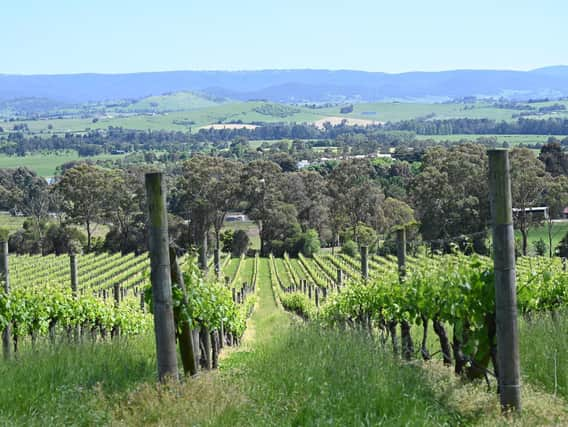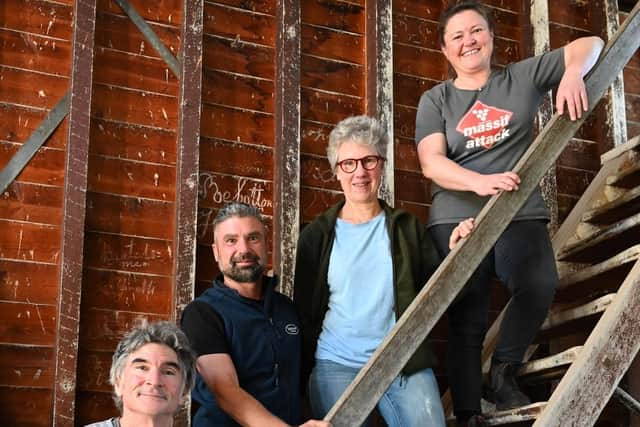Australia is home to some great wine regions and the Yarra Valley is one well worth exploring


For one thing, the seasons suit the UK traveller.
When we are heading towards winter, the southern hemisphere is starting to wake up to spring flowers, longer days and sunshine. By early November, temperatures have reached short-sleeve levels without the overbearing heat of mid-summer.
There are some people who think that the 24 or so hours that it takes to fly to Australia is just too long, but think of it as a day when you can catch up on films, reading and sleep and the time just rolls by.


Advertisement
Hide AdAdvertisement
Hide AdEvery journey needs a theme and if wine is the structure of your trip, then Melbourne in Victoria is a good place to start.
Once of the best excursions from Melbourne is the short journey out to the Yarra Valley. Less than one hour’s drive from the centre of Melbourne to the heart of the region, this makes a good day excursion, but it is better to plan to spend at least one night there to appreciate the quiet countryside and its hospitality.
The Yarra is essentially a cool climate region, suited to sheep as well as vines. It was first developed during the 19th century and there was rapid growth in vineyards, but then the region contracted before being revived almost 100 years later. Now it is home to several top-quality wineries, with Pinot Noir and Chardonnay as the main plantings but with several sites capable of ripening Cabernet Sauvignon, Merlot, Nebbiolo and Tempranillo. In 2006, the region was affected by phylloxera, which swept through, causing devastation.
This brought a challenge but also an opportunity to re-evaluate sites, row direction and planting density with the result that the Yarra has once again become a premier cool-climate region. It is still affected by phylloxera which means that many vineyards are fenced off to keep visitors out and you will have to clean your shoes before visiting any other wine region.
Key visits in the Yarra Valley:
Advertisement
Hide AdAdvertisement
Hide AdYeringberg: Founded in 1863, the original wooden winery is still standing, stacked with old wooden fermentation vats and in the corner there is a carriage which must have been the height of fashion in the mid 19th century. This building is no longer the winery but it is still used for tastings. Visits are by appointment only, mainly because this is a small, family-owned property where sheep and cattle are just as important as wine.
I visited when a fine hillside pasture was being ploughed up in preparation for a new Pinot Noir vineyard. “We used to have 88 acres of vines in the 1930s,” said Sandra de Pury, winemaker at Yeringberg and great-granddaughter of the Swiss founder of the estate. “But they were pulled out for economic reasons and now we have just nine acres, with a little more Pinot going in right now.”
Top wines include the perfumed, expressive, honeysuckle and quince-filled Yeringberg Marsanne Roussanne blend 2017 (around £33) and the harmonious, cassis and coffee-edged Yeringberg Cabernet blend 2017 (around £47).
If you can’t get to the winery, look out for Yeringberg lamb on local restaurant menus.
Advertisement
Hide AdAdvertisement
Hide AdYarra Yering: Founded in 1969 by one of the legends of the wine business, Dr Bailey Carrodus, who went on to establish Yarra Yering as a beacon of quality wine from Australia. Now winemaker Sarah Crowe continues to make powerful and complex wine styles. There is a terrific tasting room at this estate which is well worth a visit to taste these iconic wines.
Top wines include the chunky, deep-flavoured Shiraz and Viognier 2016 Yarra Yering Dry Red No 2 (£49, Hic! Wine Merchant) and the elegant, Bordeaux blend No 1 (£53, Corking Wines). Field & Fawcett has older vintages which are well worth a taste.
Giant Steps: The cellar door at this winery was being transformed with building work while I was there but it will have finished by the time we all start travelling again and the wines are well worth trying. Chardonnay and Pinot Noir are the key varietals here with altitude of the vineyard playing a major part in determining the style and freshness of the wine.
“Styles of wine in the Yarra have changed in the last five years,” said Steve Flamsteed of Giant Steps. “There is freshness and purity in the wines, and some of this has come about by changes in viticulture.”
Advertisement
Hide AdAdvertisement
Hide AdTop wines include the generous, elegant fruit of 2018 Giant Steps Chardonnay (£22.50, Harrogate Fine Wine Co) and the perfumed, subtle 2017 Giant Steps Applejack Pinot Noir.
Hoddles Creek: A small family-owned winery that is not yet open to visitors but look out for its wines on restaurant lists. Winemaker Franco d’Anna favours Nebbiolo and Tempranillo as well as Chardonnay and Pinot Noir. Top wines include the refined, perfumed 2017 Estate Pinot Noir and the bright, taut elegant 2017 Hoddles Creek Chardonnay (no local stockists).
De Bortoli: If you happen to be in Melbourne, or better still already in the Yarra Valley on a Sunday, head to the De Bortoli tasting room and restaurant at Dixon’s Creek.
It gets busy, so arrive early for a tasting, then enjoy lunch which showcases local produce with an Italian theme. De Bortoli has vineyards and wineries in different parts of south-east Australia, but the Yarra wines, including Chardonnay and Pinot Noir, demonstrate a deft touch of elegance and purity of style.
Advertisement
Hide AdAdvertisement
Hide AdWhile you are there try the Botrytis Noble One dessert wine produced in the Riverina region of New South Wales. It is sensational.
Editor’s note: first and foremost - and rarely have I written down these words with more sincerity - I hope this finds you well.
Almost certainly you are here because you value the quality and the integrity of the journalism produced by The Yorkshire Post’s journalists - almost all of which live alongside you in Yorkshire, spending the wages they earn with Yorkshire businesses - who last year took this title to the industry watchdog’s Most Trusted Newspaper in Britain accolade.
And that is why I must make an urgent request of you: as advertising revenue declines, your support becomes evermore crucial to the maintenance of the journalistic standards expected of The Yorkshire Post. If you can, safely, please buy a paper or take up a subscription. We want to continue to make you proud of Yorkshire’s National Newspaper but we are going to need your help.
Advertisement
Hide AdAdvertisement
Hide AdPostal subscription copies can be ordered by calling 0330 4030066 or by emailing [email protected]. Vouchers, to be exchanged at retail sales outlets - our newsagents need you, too - can be subscribed to by contacting subscriptions on 0330 1235950 or by visiting www.localsubsplus.co.uk where you should select The Yorkshire Post from the list of titles available.
If you want to help right now, download our tablet app from the App / Play Stores. Every contribution you make helps to provide this county with the best regional journalism in the country.
Sincerely. Thank you.
James Mitchinson
Editor
